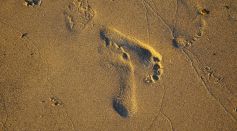ENVIRONMENT & CLIMATE

Shark Bites a Snorkeller in United Kingdom’s Cornwall Shores

10,000-Year-Old 'Ghost Footprints' Found in Utah Desert Only Appears After It Rains
Fruits Can Go Extinct, Too! Here Are 5 of Them
Fish Waste Benefit Uses Synthesis Process to Turn Then Useless Material Into Carbon-Based Nanomaterial
Artificial Vision Developed Using Fish Eyes for More Effective Optical System for Aquatic, Terrestrial Territories

Climate Change Causes Mass Extinctions: Humans, Animals, Plants Species May Have Shorter Time to Adapt

Student Built Zem Car Cleans Air While Driving Reducing Carbon Emission

Scientists Unlock Mysterious Mechanism of Centromeres That May Enable Stress Resistant Organisms
Asexual Reproduction Doubles the Risk of Having Harmful Genetic Mutations, Study Reveals

25-Year-Old Woman Shockingly Finds 5-Inch Imperial Moth With a Face and Name 'Anna' Written on Its Back

Earth's Rotation Is Faster Than Usual, Leading to the Shortest Day Recorded

Inner Ear Canal Gives Paleontologists Insights on Mammal Evolution

Shark Pregnancy: Some Species Can Carry Their Babies for Up to 3 Years

Europe's Last Panda Species Discovered in Bulgaria Didn't Only Eat Bamboo
Most Popular

Largest Known Volcanic Aquifer Discovered Beneath Oregon's Cascades

New 'Supergiant' Sea Bug Found in South China Sea, Named After Darth Vader

Mediterranean Sea Was Refilled by a Catastrophic Flood Millions of Years Ago

Mysterious Cosmic Waves That Sound Like Birds Detected in Unexpected Space Region





